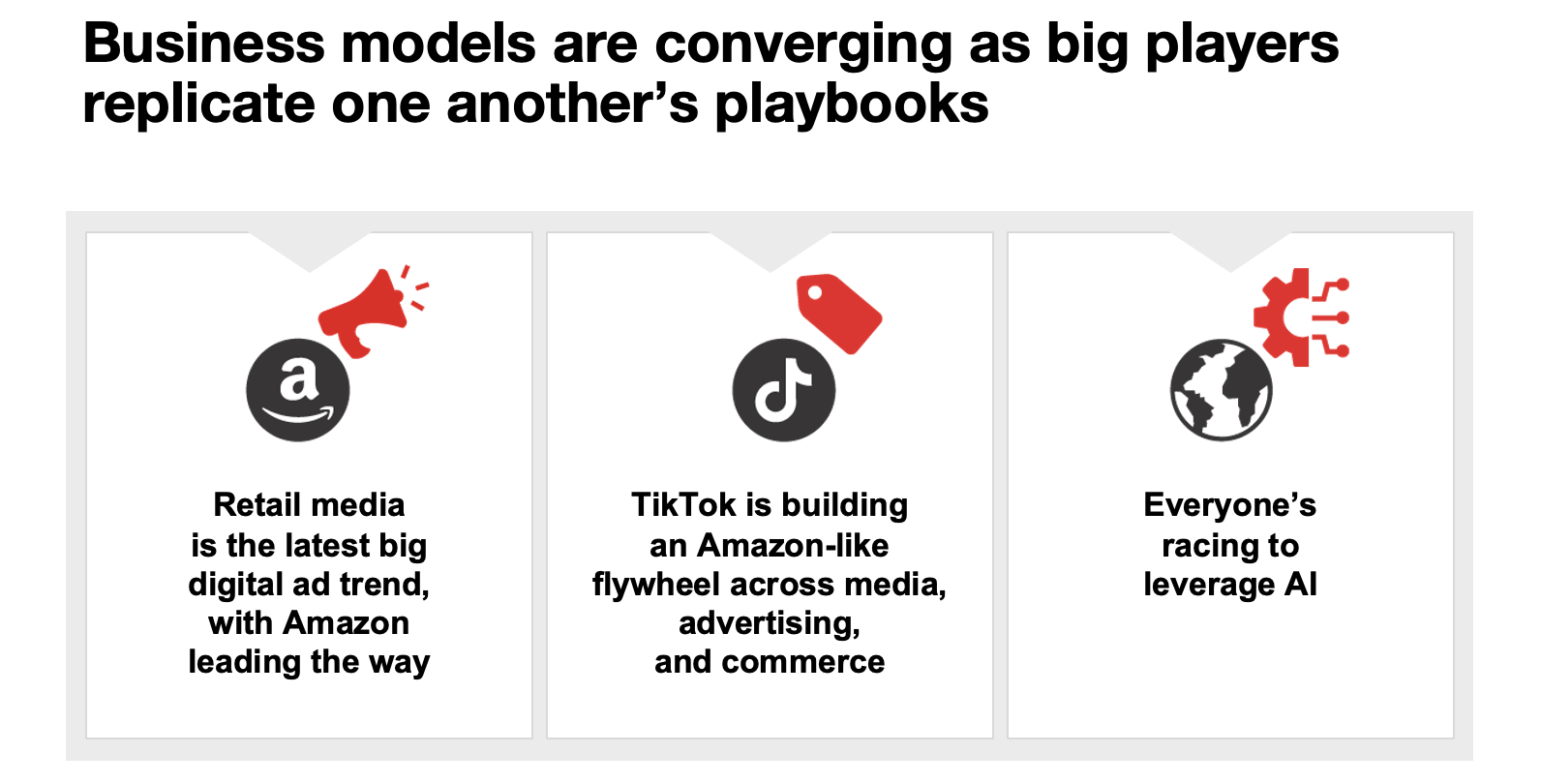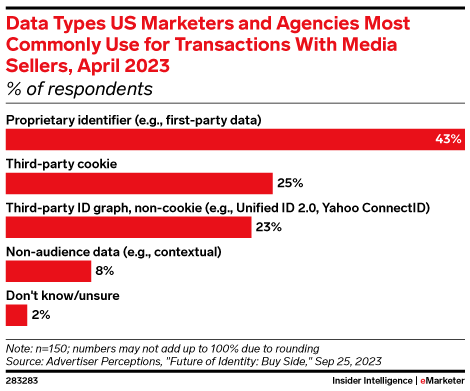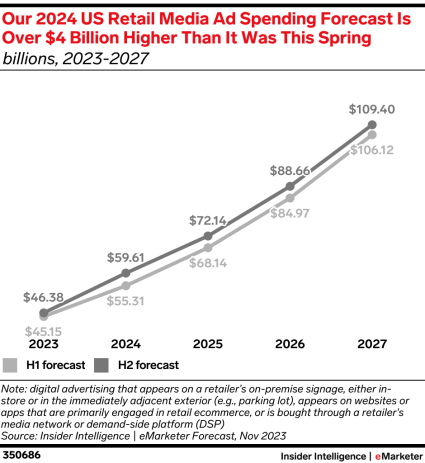In the past, there was a clear divide between different media forms, and marketers generally knew what to expect from them.
But that’s all changed. Platforms are now competing on all fronts: they need to capture consumer attention and keep users engaged, contend with cookie deprecation, and incorporate new capabilities like artificial intelligence (AI) and augmented reality (AR), all to make the case to advertisers that they’re uniquely primed to deliver performance results.
The lines between “channels” have never been more blurred: social is search, retail media is TV, video is everywhere. This spectacular collapse of traditional marketing disciplines is the result of media convergence.
Convergence is why today’s media landscape can feel more Mad Max than Mad Men, an arms race between platforms to do absolutely everything. And this battle royale isn’t likely to end soon, as platforms continue to jockey for advertiser dollars while minimizing friction in the consumer buying experience.
But the real question marketers need to consider isn’t which platforms will end up triumphant; it’s how your brand can win in this fast-changing landscape. To take full advantage of new opportunities, you’ll need a strong integrated strategy and a keen eye for maximizing the value of data.
Pull it together: breaking down siloes to build a holistic media strategy
Your brand can’t thrive in this newly convergent world without a strategy that takes an overall view of the media landscape into account.
Both brands and agencies have traditionally been structured around siloed teams with deep expertise in each type of media, but that model is outdated and broken. You need to set up cross-functional teams where experts in different media disciplines work together so knowledge and ideas can cross-pollinate and budgets can be shifted across channels or platforms to follow demand.
That’s critical when it comes to moving quickly to take advantage of major trends like:
- Search on social platforms: More and more consumers are starting their search for products or solutions not on Google or Bing, but on platforms like TikTok, Reddit, and Amazon. Search engines are partnering with social networks more and more, including Bing in Snap’s MyAI via sponsored links, Bing in Meta’s AI via info in text-based chats, and Google in TikTok results.
- Social commerce: The line between ecommerce and social is getting blurrier. TikTok Shop, Instagram Shop, and Amazon’s partnerships with Meta, Snap, and Pinterest are leading the charge for innovation in this space; customers don’t even have to leave the social platform they’re on to make a purchase.
- Programmatic/CTV: Shoppable video has become an increasingly attractive option for both consumers and marketers alike. Amazon has found a way to merge its streaming inventory with its marketplace so that consumers can shop while they watch.

Source: eMarketer
But sometimes internal solutions don’t go far enough. To better understand your customers and maximize impact, you can bring in outside strategists, who can help you get a clearer sense of the overarching media landscape and push your brand to think outside the box. You should also lean into internal and external partnerships, teams, or agencies that can think more broadly and collaborate across functions seamlessly.
Strategists can help you get a better understanding of where your audience is, what they want to consume, what inventory is available, how you should transact against it, and how impact can be measured so you can evaluate and identify the best platforms to align with your brand and media goals.
Get ready: building a strong data foundation for the cookieless future
Despite numerous fake-outs and delays, Google is turning off third-party tracking cookies for 1% of Chrome internet traffic in early 2024 to test new ad tech options from the Privacy Sandbox at scale.
Marketers have been bracing for this long-awaited change for a long time, but it’s only the beginning. When the cookieless future arrives, brands will need to fully shift from a strategy largely based on third-party to first-party data. You should already be taking steps to prepare your media strategy for this new reality.
Signal resilience is extremely important for both your data framework and any tags/CAPI/scaled approaches. Embracing additional forms of qualified data (like retailer data) and deploying advanced measurement and incrementality testing will also be crucial.
Media teams need to put a process for prioritizing capture and analysis of first-party data in place now, because it will only become more important as the lines between media platforms blur.

Source: Advertiser Perceptions
Wpromote’s approach injects data into every decision, which gives our clients a distinct advantage in the market; to make that a reality for your brand, strategists and leadership need to work hand in hand with data teams and marketplace partners to build a strong data foundation that powers effective reporting and analysis so they are empowered to gather and use insights meaningfully in media plans or optimizations.
Hedge your bets: choosing the right platforms to support your media strategy
Once you’ve prepared your marketing org to make better media decisions based on data and cross-functional collaboration, you need to find the right platforms that will help you achieve your business goals. Item number one on your platform checklist should be optimal data partnerships and/or unique, scaled data on consumers.
We can’t talk about optimal data partnerships or converged media without discussing retail media networks (RMNs) like Amazon, Walmart, Kroger, or Target. RMNs have a been big topic of discussion for marketers over the last few years, and for good reason; eMarketer predicts that US ad spending on RMNs will be almost a billion dollars higher in 2024 than in 2023, $4 billion higher than their previous forecast.

Source: eMarketer
RMNs are a good option for brands looking to unlock new audience and data opportunities because they offer access to first-party data that can help fill the void left behind by third-party tracking. This data will also become more granular as inventory opens up, thanks to platforms like Amazon and Walmart Connect that are moving fast to innovate and bring new capabilities to market.
Beyond RMNs themselves, you should consider partners like The Trade Desk, which has deliberately built up its retailer partnership ecosystem to unlock the best data and inventory opportunities. That augments TTD’s industry-leading programmatic capabilities; RMNs aren’t the only platforms growing and innovating, after all. Programmatic is also having a banner year and has already overtaken linear TV in terms of market share.
That growing dominance has been powered by several factors: new ad-supported inventory from streaming services like Netflix and Disney+, the decline of traditional channels, and continued synergies between programmatic and marketplaces. The growing variety of programmatic ad types is also a source of significant opportunities, from OTT to DOOH.
TikTok is also challenging traditional boundaries as it expands from its original role as a social media app to TikTok Search, TikTok Out-of-Phone, and TikTok Shop, leaning into its strengths around creators, affiliates, live streaming, and creative.
We’ll continue to see the walls between platforms break down in the next few years as AI, signal loss, consumer behavior, and more make their mark on the industry. This pace of change makes one thing crystal clear: brands need to set aside budget to test out new ad types, tactics, and platforms. If you don’t, you risk lagging behind competitors that are already taking advantage of these offerings.
It’s time to fully commit to an integrated media vision. The brands that win in 2024 and beyond won’t afraid to make big changes to succeed in a more holistic future.







Responses